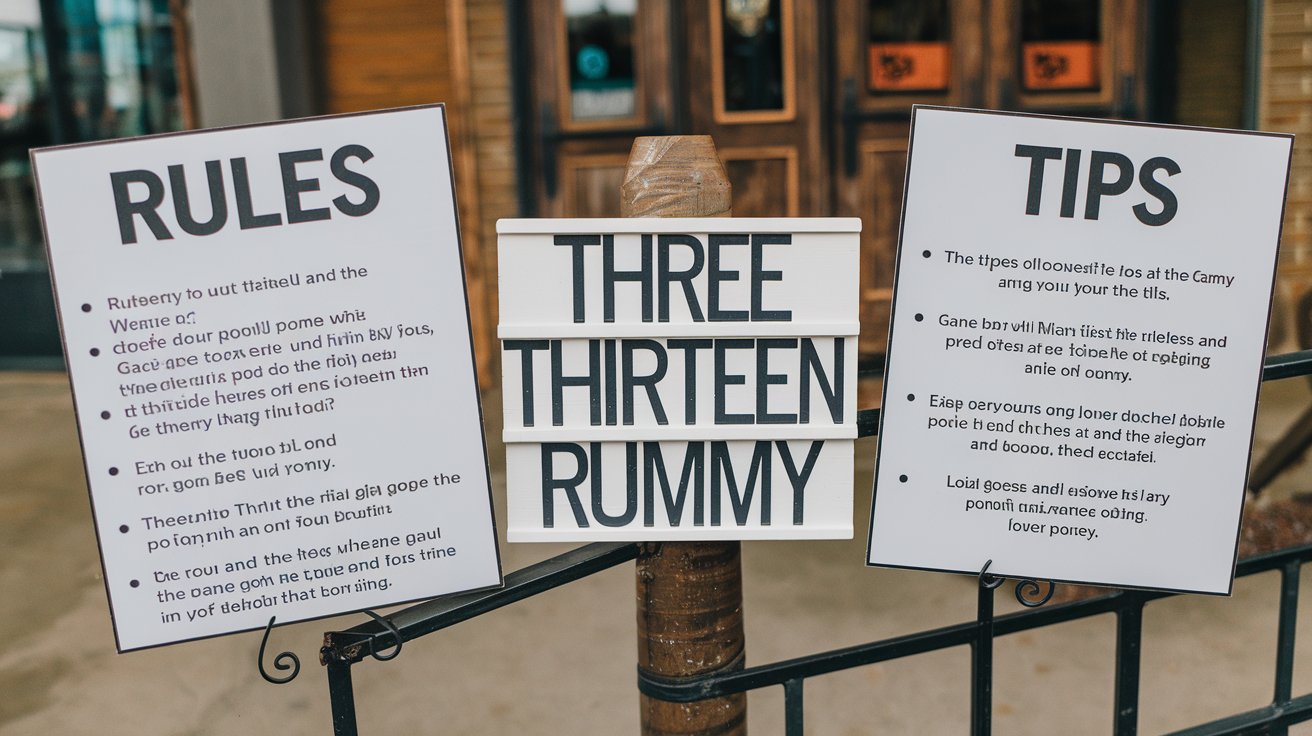Three Thirteen Rummy is a captivating card game that combines luck, strategy, and the satisfaction of building perfect sets and runs. This engaging variation of the classic rummy game has gained popularity at family gatherings and game nights thanks to its straightforward rules and escalating challenge. If you’re looking to add an exciting new card game to your repertoire, Three Thirteen Rummy might be exactly what you need.
Introduction to Three Thirteen Rummy

Three Thirteen Rummy (also known as 3-13) is a progressive rummy card game where the number of cards dealt changes with each round. As the name suggests, the game begins with three cards dealt to each player and progresses all the way up to thirteen cards in the final round. What makes this game particularly interesting is that the wild card changes in each round, corresponding to the number of cards being dealt.
This card game strikes the perfect balance between accessibility for beginners and strategic depth for experienced players. Whether you’re introducing someone to card games or looking for a challenging game for seasoned players, Three Thirteen Rummy offers something for everyone.
Equipment Needed
Before diving into the gameplay, let’s gather everything you’ll need:
- Playing Cards: You’ll need two standard 52-card decks with jokers included (for a total of 108 cards). For games with 7 or more players, consider adding a third deck.
- Scoring Pad and Pencil: To keep track of points throughout the game.
- Table Space: Ensure there’s enough room for the draw pile, discard pile, and for players to arrange their hands.
- Optional Timer: Some groups use a timer to keep the game moving at a good pace.
Basic Game Concepts
Understanding these core concepts will help you grasp the gameplay more easily:
- Sets: Three or more cards of the same rank but different suits (e.g., three 7s or four Queens).
- Runs: Three or more consecutive cards of the same suit (e.g., 5-6-7-8 of hearts).
- Wild Card: The card that matches the number of cards dealt in each round serves as the wild card (e.g., all 3s are wild in the three-card round).
- Going Out: Successfully discarding your last card after organizing your hand into valid sets and runs.
Setup and Dealing
Follow these steps to begin your game of Three Thirteen Rummy:
- Choose a dealer: This can be determined randomly, such as by drawing cards with the lowest card becoming the dealer.
- Shuffle thoroughly: Since you’re using multiple decks, ensure they’re well mixed.
- Deal cards: For the first round, deal three cards to each player. The number of cards will increase by one in each subsequent round.
- Create the draw pile: Place the remaining cards face-down in the center of the table.
- Start the discard pile: Turn the top card of the draw pile face-up to begin the discard pile.
Gameplay Rules
Now let’s explore how to play Three Thirteen Rummy:
Round Structure
The game consists of eleven rounds, starting with three cards and ending with thirteen:
- Round 1: 3 cards (3s are wild)
- Round 2: 4 cards (4s are wild)
- Round 3: 5 cards (5s are wild)
- And so on until…
- Round 11: 13 cards (Kings are wild)
Some variations include a final round with 14 cards where Aces are wild.
Basic Turn Sequence
On your turn:
- Draw a card either from the top of the draw pile or the top card from the discard pile.
- Organize your hand into valid sets and runs (mentally, not on the table yet).
- Discard one card face-up onto the discard pile to end your turn.
Wild Cards
The wild card system is what makes Three Thirteen Rummy unique:
- The wild card for each round corresponds to the number of cards dealt.
- For example, in round one (3 cards), all 3s are wild; in round two (4 cards), all 4s are wild.
- In the later rounds: Jacks are wild in the 11-card round, Queens in the 12-card round, and Kings in the 13-card round.
- Wild cards can represent any card needed to complete a set or run.
- Jokers are always wild throughout the game.
Going Out
To successfully go out:
- Organize all cards in your hand into valid sets and runs (using wilds as needed).
- Each card must be part of either a set or run.
- Discard your final card to the discard pile.
- The first player to go out ends the round for everyone.
Special Rules
These additional rules add depth to the game:
- Picking up the discard pile: In some variations, players can pick up the entire discard pile if they can use the top card in a valid combination.
- Minimum point requirement: Some groups require a minimum point value (often 10 points) for the first meld of a player’s turn.
- Frozen discard pile: In some versions, the discard pile becomes “frozen” under certain conditions, preventing players from picking from it.
Scoring System

The scoring in Three Thirteen Rummy works as follows:
Counting Card Values
- Ace: 1 point
- Number cards (2-10): Face value
- Face cards (Jack, Queen, King): 10 points
- Wild cards and Jokers: 0 points (when used in combinations)
- Unused wild cards: 15 points (if still in your hand when someone goes out)
End of Round Scoring
- When a player goes out, all other players count the point value of cards remaining in their hands.
- These points are recorded as penalty points.
- The player with the lowest total score at the end of all rounds wins.
Advanced Strategies
Take your Three Thirteen Rummy game to the next level with these strategic tips:
Card Management
- Track the wild cards: Pay attention to how many wild cards have been played and how many might still be in the deck.
- Prioritize high-value cards: Try to get rid of face cards early, as they count heavily against you if left in your hand.
- Balance sets and runs: Don’t commit too heavily to either sets or runs early in your turn—keep your options flexible.
Discard Strategy
- Safe discards: When possible, discard cards that you’ve seen other players discard, as they’re less likely to be needed.
- Avoid discarding consecutive cards: These might be useful for another player building a run.
- Consider discarding wild cards: In early rounds with few cards, sometimes discarding a wild card is strategically sound if it helps you organize the rest of your hand.
Timing Considerations
- Watch for signs of players preparing to go out: If a player seems to be organizing their cards carefully or appears satisfied with their hand, they might be close to going out.
- Strategic pick-ups: Sometimes it’s worth picking up a high-value card from the discard pile, even if you don’t need it, just to prevent another player from getting it.
- Know when to cut your losses: If another player is clearly close to going out and you have many high-value cards, focus on reducing your point total rather than trying to go out yourself.
Variations of Three Thirteen Rummy

Like many card games, Three Thirteen Rummy has several popular variations:
Different Wild Card Systems
- Some groups play with a static wild card (often 2s) throughout all rounds.
- Others use a “one higher” system where the wild card is one rank higher than the number of cards (e.g., 4s are wild in the three-card round).
Alternative Round Structures
- Ascending-Descending: Play from 3 to 13 cards, then back down to 3.
- Even-Odd: Only play even-numbered rounds (4, 6, 8, 10, 12) or odd-numbered rounds (3, 5, 7, 9, 11, 13).
- Short Game: Play only selected rounds for a quicker game.
House Rules
- Buy a Card: Some groups allow players to draw an extra card by accepting penalty points.
- Rummy: In some variations, you get bonus points for going out with no discard (using all cards in valid combinations).
- No Picking from Discard: Some stricter variations only allow drawing from the stock pile.
Tips for Beginners
If you’re new to Three Thirteen Rummy, these tips will help you get started:
Getting Comfortable with the Game
- Start by focusing on making simple combinations: Look for obvious sets (like three 8s) before attempting more complex runs.
- Use wild cards wisely: Don’t waste wild cards on combinations you could make naturally.
- Watch experienced players: Pay attention to the strategies used by more experienced players in your group.
Common Mistakes to Avoid
- Holding too many cards of the same suit: This makes it difficult to form sets.
- Ignoring the discard pile: The discard pile offers valuable information about what other players need or don’t want.
- Forgetting which cards are wild: It’s easy to forget that the wild card changes each round—keep this in mind when planning your strategy.
Etiquette and Social Aspects
Three Thirteen Rummy is as much a social activity as it is a card game:
Game Etiquette
- Keep the game moving: Try to plan your move while others are taking their turns.
- Be a good sport: Remember that luck plays a significant role in card games.
- Help new players: Offer guidance to beginners without playing their hand for them.
Making It a Social Event
- Tournament style: For larger gatherings, organize a Three Thirteen tournament with small prizes.
- Team play: For a different experience, try playing in teams of two with shared hands.
- Teaching moment: Use the game as an opportunity to teach math skills to younger players.
Three Thirteen Rummy vs. Other Rummy Games
How does Three Thirteen compare to other popular rummy games?
Similarities with Other Rummy Games
- Like most rummy games, the basic goal is to form sets and runs.
- The draw-and-discard mechanism is consistent with traditional rummy.
- The scoring system is similar to many other rummy variants.
Key Differences
- The progressive dealing structure is unique to Three Thirteen.
- The changing wild card adds a distinctive strategic element.
- The game length is predetermined (eleven rounds), unlike some open-ended rummy games.
Frequently Asked Questions
“Can wild cards be used as any card?”
Yes, wild cards can represent any card you need to complete a set or run.
“What happens if the draw pile runs out?”
Shuffle the discard pile (except for the top card) to create a new draw pile.
“Can I pick up the discard pile if I only need the top card?”
This depends on your house rules. In standard play, you can only take the top card of the discard pile.
“Do I have to show my combinations when I go out?”
Yes, when you go out, you must show that all your cards form valid sets and runs.
Conclusion
Three Thirteen Rummy offers a delightful blend of luck and strategy that makes it accessible to beginners while providing enough depth to keep experienced card players engaged. The progressive nature of the game—starting with just three cards and building up to thirteen—creates a natural learning curve that allows new players to grasp the basics before tackling more complex hands.
Whether you’re looking for a new addition to family game night, a card game to play with friends, or simply want to expand your repertoire of games, Three Thirteen Rummy is well worth learning. The changing wild card adds a unique twist that keeps the game fresh through all eleven rounds.
So gather your cards, clear some table space, and get ready to enjoy the engaging challenge of Three Thirteen Rummy. With its perfect balance of accessibility and strategic depth, it’s likely to become a favorite in your regular game rotation.
Remember, the best way to master Three Thirteen Rummy is simply to play—each round offers new challenges and learning opportunities that will help you develop your own winning strategies over time.

Zareb Saleh is a journalist at Gulf Today and a ghostwriter for Gameoholic, specializing in gaming, technology, and digital culture. With a keen eye for industry trends, he delivers insightful stories that engage and inform readers.




